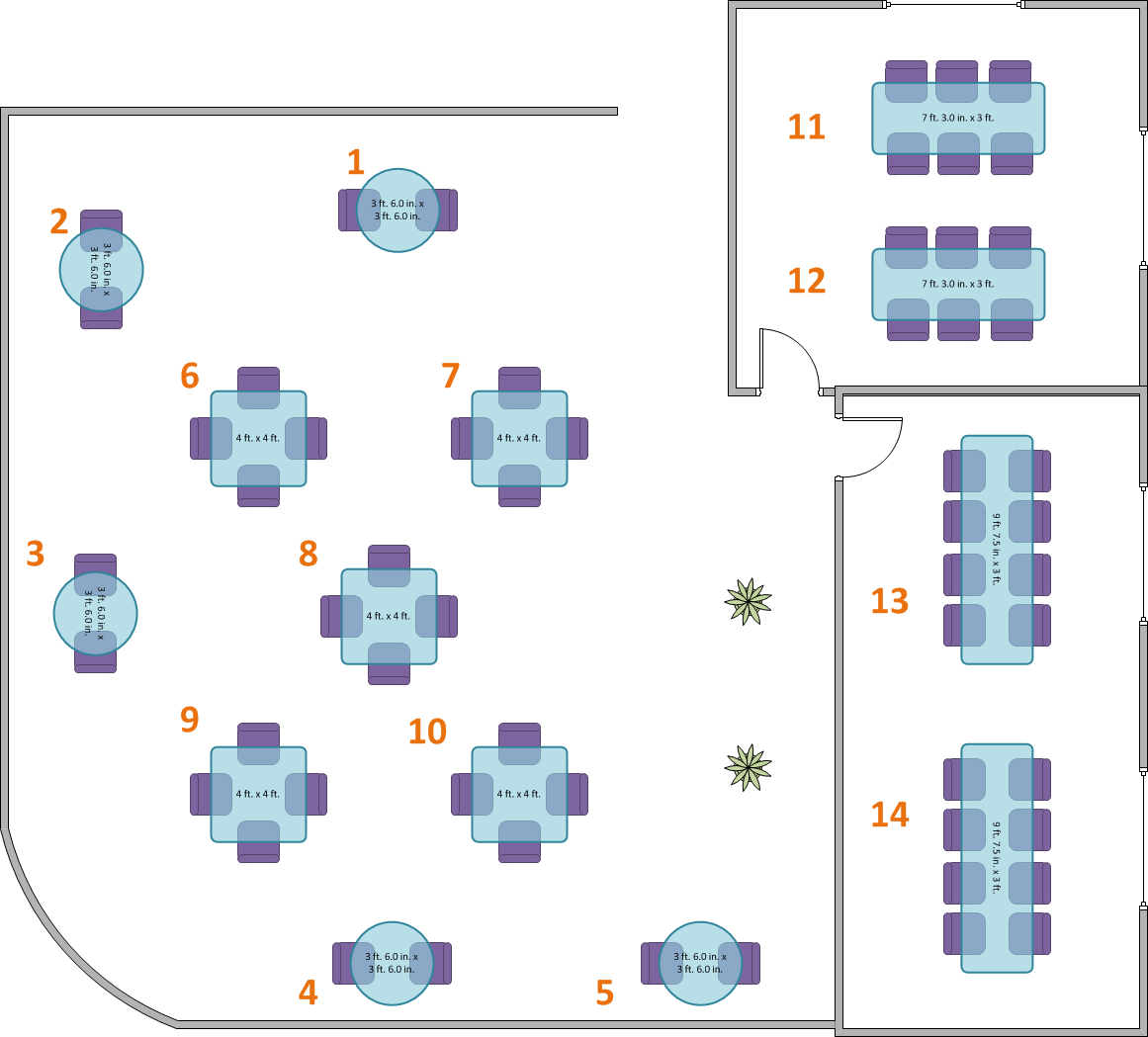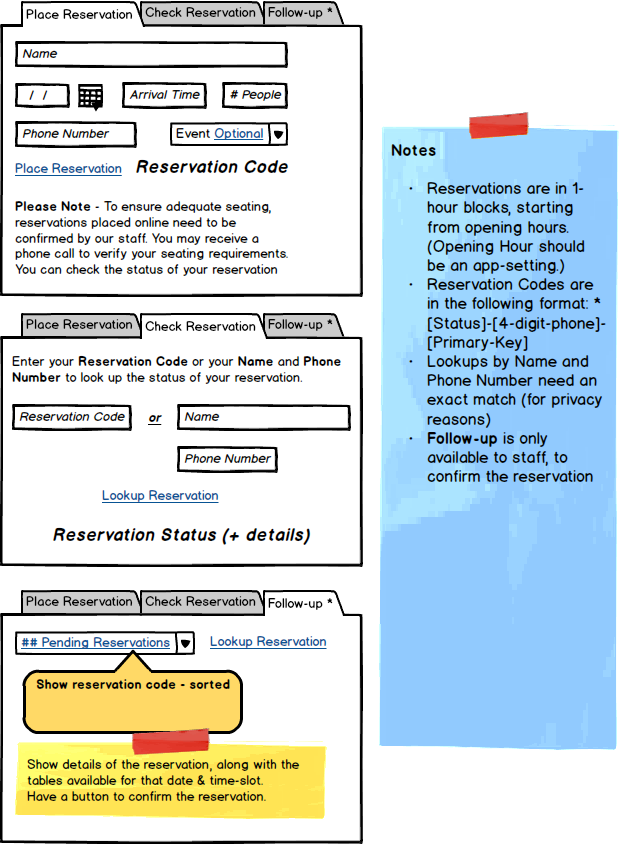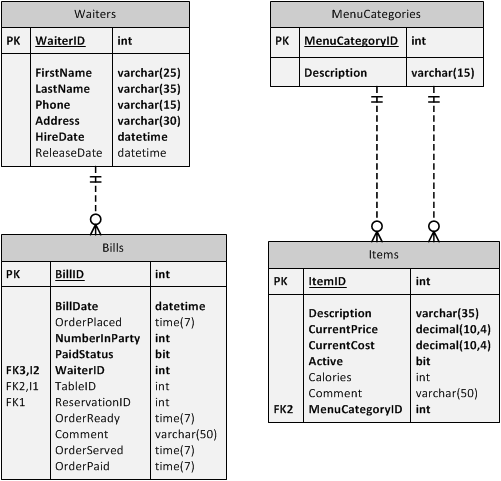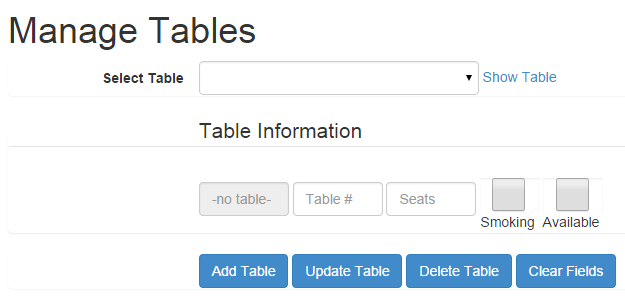# eRestaurant Background Story
This is a background story for the eRestaurant sample used in class.

# EatIn - An eRestaurant
At EatIn, a small restaurant that takes walk-in customers as well as reservations, they need a system to make it easier for their waiters and kitchen staff to communicate over customer orders and plan reservations. The system is a web-based application supported by a database.

# Servers
Waiters need to seat customers when they arrive and tables are available. They then take customer orders and update orders as customers change their minds or order extra items. When waiters enter the order details on their hand-held device (e.g.: smartphone or tablet), the order information is automatically available to the kitchen. Waiters are notified by the kitchen when the order is ready so that they can get the order and serve the customer. At the end, the waiter gives the bill to the customer and the customer goes to pay for the order.
Additionally, waiters are sometimes asked to split the bill for the party, or combine bills for the party at the table(s).
# Online Menu
Customers like to see the online menu. Additionally, we are looking at incorporating special Multitouch Coffee Table that customers can peruse while waiting to be seated.
# Kitchen
The Kitchen staff prepare orders as they are received from the waiters. When the order is ready, the staff note it on the bill and the waiters are automatically updated (SignalR - Advanced scenario).

# Online Reservation
Customers are able to place reservations on-line, and can indicate if the reservation is for a special event. Staff use the same system to place reservations received by phone. (When customers place the reservation, they need to use a captcha; logged-in staff do not need to use a captcha).
# Managers
These images can be used in your app.
Managers perform administrative tasks (including placing reservations). Data that needs to be maintained includes managing menu items, waiters, tables/seating, and special event categories.
# eRestaurant ERD
Each Waiter may be in charge of one or more Bills. Each Bill must be managed by one and only one Waiter.
Each Bill may be made up of one or more BillItems, wherein each BillItem must be for one and only one Item on the menu. Each Item on the menu may be ordered as part of one or more BillItems where the BillItem must be associated with one and only one Bill.
Each Bill must be associated with either one and only one Table or one and only one Reservation. Each Table may be used to identify one or more Bills at the current moment. Likewise, each Reservation may be paid for through one or more Bills at the time of the reservation.
Each Reservation may be placed for one and only one SpecialEvent. Each SpecialEvent may be the occasion for one or more Reservations.
Each Reservation must be specifically allocated for one or more Tables. Each Table may be reserved for one or more Reservations. (This many-to-many association is resolved through an intermediary ReservationTable.)

# Template
Each Table [must|may] be relationship one [and only one|or more] Table2.
# Demo/Practice Usage
The following list outlines the usage of the various parts of the eRestaurant database as demos and practice items.
- Entitles & DAL
- Demo -
Table,SpecialEvent,Reservation- Use the following business rules:

- Table.TableNumber - - int, required, sequential, unique
- Table.Capacity - values of 2, 4, 6, 8, or 10 only
- Table.Smoking - disabled (no longer allowed in public restaurants)
- SpecialEvent.EventCode - required, PK, 1 character
- SpecialEvent.Description - required, 5-30 characters
- SpecialEvent.Active - default is True for all new Special Events (managed in Constructor)
- Practice -
Waiter,Item,Bill,MenuCategory- Use the following business rules:

- Waiter.FirstName - required, 2-25 characters
- Waiter.LastName - required, 2-35 characters
- Waiter.Phone - required, 4-15 characters
- Waiter.Address - required, 8-30 characters
- Waiter.HireDate - required
- Waiter.ReleaseDate - optional
- Item.Description - required, 5-35
- Item.CurrentPrice - required, >0, <=50
- Item.CurrentCost - required, >0, <=50
- Item.Calories - optional, >=0
- Item.Comment - optional
- Item.MenuCategoryID - required
- Post-Practice - BillItem (with navigation properties) - Use the following business rules:
![Tables for Post-Practice usage]./(eRestaurant_ERD_entity-post-practice-tables.png)- BillItem.Quantity - required, >0
- BillItem.SalePrice - required, >=0.00
- BillItem.UnitCost - required, >=0.00
- BillItem.Notes - (for BLL usage) when the sale price and/or unit cost are zero or the sale price does not equal the quantity times the unit cost, then a note is required
- BLL
- Demo - CRUD methods for Table and SpecialEvent, with
[DataObjectMethod()]attributes for SpecialEvent methods. - Practice - CRUD methods for Waiter, Item and MenuCategory, with
[DataObjectMethod()]attribues for Item methods.
- PL - CRUD functionality
- Demo
- Table - Create a simple CRUD form for managing table information using code-behind (similar to how it was done in the previous course)

- SpecialEvent - Create a CRUD form for managing SpecialEvent information using a ListView and ObjectDataSource.

- Table - Create a simple CRUD form for managing table information using code-behind (similar to how it was done in the previous course)
- Practice
- Waiter - Create a simple CRUD form for managing Waiter information using code-behind (similar to how it was done in the previous course)

- Item & MenuCategory - Create a CRUD form for managing menu items and their categories using a pair of ListView and ObjectDataSource controls; manage both items on the same page.
- Waiter - Create a simple CRUD form for managing Waiter information using code-behind (similar to how it was done in the previous course)
- CQRS
- Menu Items - Displaying menu item information to the end-user
// LinqPad snippet for getting menu items
from cat in MenuCategories
orderby cat.Description
select new
{
Description = cat.Description,
MenuItems = from item in cat.Items
where item.Active
orderby item.Description
select new
{
Description = item.Description,
Price = item.CurrentPrice,
Calories = item.Calories,
Comment = item.Comment
}
}